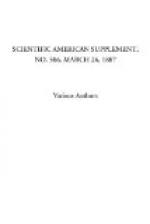[Illustration: FIG. 3.—“SENSIM” SCREW GILL—PLAN.]
In the ordinary gill box, the feed and delivery rollers are fluted, in order the better to retain in the first instance their grip upon the wool passing through, and in the second to enable them to overcome any resistance that might be offered to drawing the material. It thus often happens in this class of machines that a large percentage of the fibers are broken, and thus much waste is made. The substitution of plain rollers in both these positions obviates most of this mischief, while in combination with the other parts of the arrangement it is almost precluded altogether.
It will be obvious from what we have said that the special features of this machine, which may be summarized as, first, the use of a screw thread of graduated pitch; second, an increased length of screw action and an additional number of fallers; and third, the use of light plain rollers in place of heavy fluted back and front rollers, enable the inventor to justly claim the acquisition of a number of advantages, which may be enumerated as follows:
The transformation of the gills from mere carriers into constant workers during the whole of their outward traverse, by which the work is done much more efficiently, more gently, and in greater quantity than by the old system with uniformly pitched screws. A great improvement in the quality of the work, resulting from the breakage of fiber being, if not entirely obviated, nearly. An increased yield and better quality of top, owing to the absence of broken fiber, and consequent diminution of noil and waste. The better working of cotted wools, which can be brought to a proper condition with far more facility and with diminished risk of breaking pins than before. A saving in labor, space, and plant also results from the fact that the wool is as well opened and straightened for carding with a passage through a pair of improved boxes as it is in going through four of the ordinary ones, while the quantity will be as great. Owing to the first feature referred to, which distributes the strain over all the gills, a greater weight of wool can be put into them and a higher speed be worked. The space occupied and the attendance required is only about half that of boxes required to do the same amount of work on the old system. Taking the flutes out of the feed and delivery rollers, and greatly diminishing their weight, it is estimated will reduce by 90 per cent. the wear and tear of the leather aprons, and thus to that extent diminish a very heavy annual outlay incident to the system generally in vogue. A considerable saving of power for driving and of time and cost of repairs from the bending and breakage of pins also results. Shaw, Harrison & Co., makers, Bradford.—Textile Manufacturer.
* * * * *
NOTES ON GARMENT DYEING.
Black wool dresses for renewing and checked goods, with the check not covered by the first operation, are operated upon as follows:




